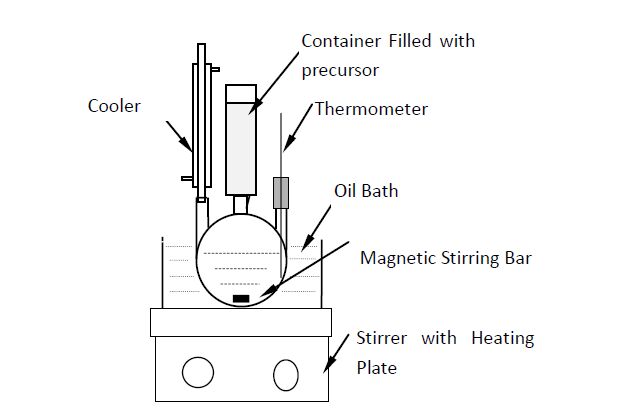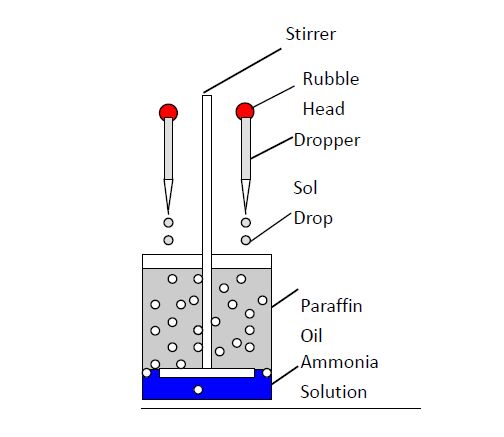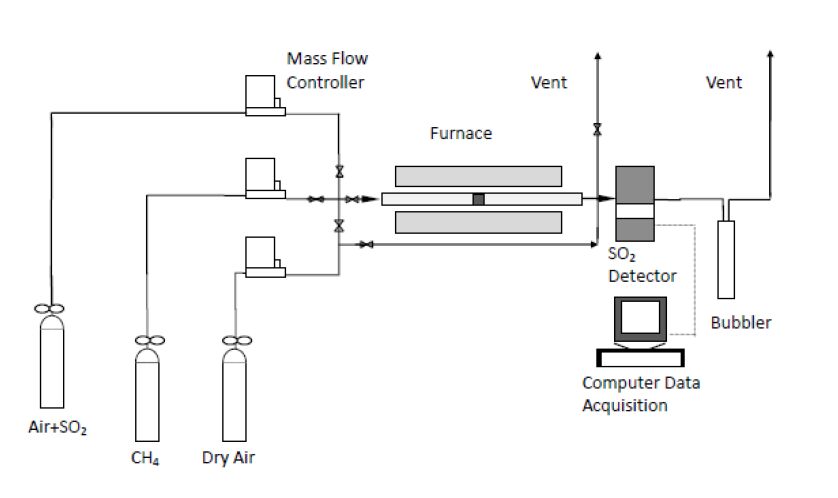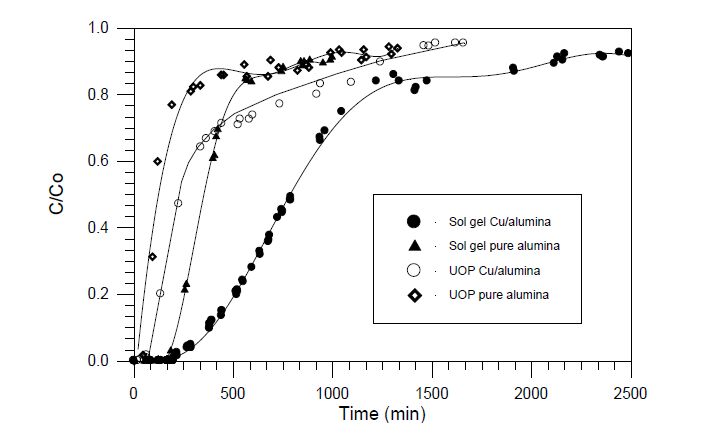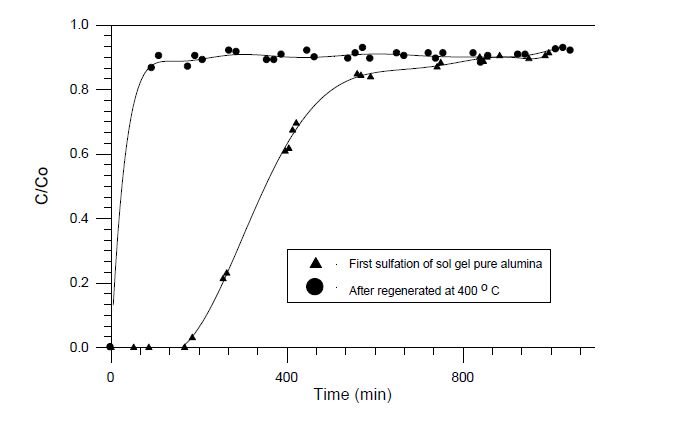1. Introduction
The copper oxide process is effective for simultaneous removal of SO2 and NOx from flue gas with over 95% removal efficiency [1,2]. The granular γ-Al2O3 support of commercial sorbents (e.g., Alcoa and UOP) used in the copper oxide process are prepared from alumina powder by traditional granulation methods such as tumble growth. The γ-Al2O3 supported CuO sorbents are then produced by impregnating the porous γ-Al2O3 support with a solution of cupric salt which is decomposable to Cu ion or CuO. The major problems associated with the use of these CuO/γ-Al2O3 sorbents in the moving-bed copper oxide process are high attrition rate and lower chemical reactivity of the sorbents used. Additionally, these commercial alumina supports have a smaller surface area (<200 m2/g). This limits the amount of CuO that can be dispersed on the support surface, and therefore the reactivity of the sorbent. Recently, nanostructured materials attracted a lot of attention in increasing the adsorption capacity of adsorbent [3,4] and improving the catalytic properties of the catalysts [5,6]. There are a number of ways to prepare the nanostructured catalysts and adsorbents, such as flame aerosol process [7], and sol-gel process [3]. In this study, we report the test results for desulfurization process using the sol-gel derived granular alumina supported CuO sorbent. The newly developed sol-gel process for preparing granular alumina supported CuO sorbents with good mechanical properties and the desired pore structure has been proved to be very efficient at removing sulfur dioxide [8]. Details of the synthesis of the pure γ-Al2O3 and γ-Al2O3 supported CuO granular sorbents were reported earlier [3,4]. The present paper reports sulfation properties of the sol-gel derived γ-Al2O3 supported CuO granular sorbents based on fixed-bed measurements.
Removal of SO2 with supported copper sorbents drew much attention after the patent covering impregnation of copper into support was issued to Shell International Research in 1970 [10] and the paper was published by McCrea et al. [11]. There are several advantages for the use of copper oxide as a desulfurization agent over other metal oxides. Both adsorption and regeneration take place at similar temperatures (400-450 °C) which is around the temperature at the exit of the boiler [12]. Copper oxide/copper sulfate can also act as a selective catalyst for NOx reduction. Finally, under certain conditions, copper oxide removes most of the SO2 from the flue gas.
McCrea et al. reported that absorption of SO2 from flue gas occurs readily above 300 °C or above and is most rapid when the support contains 4 to 6 wt% copper. At higher temperatures (>450 °C), both the reverse reaction and decomposition reaction CuSO4 ↔ CuO + SO3 become significant. Considering both the capacity and rate, the optimum concentration of Cu was found to be from 4 to 6 wt%. A copper content more than 4-6% led to a decrease in the SO2 adsorption rate, probably due to a decrease in the sorbent porosity. On the other hand, if the content of copper was lower than 4 wt%, the adsorption rate was also low, likely due to incomplete coverage of the internal surface area. They also found that γ-Al2O3 support itself was sulfated.
Friedman et al. [13] extensively studied the catalyst, CuO/Al2O3. Their important conclusions were: (1) at low metal loadings (<4% Cu/100 m2/g support) and at calcination below 500 °C, formation of a "surface spinel" (which resembles CuAl2O4) dominates. Most of Cu2+ ions are in a distorted octahedral geometry, unlike bulk CuAl2O4 where about 60% are tetrahedral and 40% octahedral. (2) At higher metal loadings segregation of bulk-like CuO may also occur. Both metal loading and calcination temperature are key factors in determining the extent of metal-support interaction. By investigating the interaction of cupric ions with γ-Al2O3 supports, they found that even for different γ-Al2O3, there is a similar threshold loading for the appearance of crystalline cupric oxide, which is approximately 4 wt% Cu/per 100 m2/g support surface area. Below this critical load, no CuO peak was detected, whereas above it, the CuO or CuAl2O4 was detected by XRD.
Strohmerier et al. [14] confirmed the conclusions of Friedman et al. At low Cu loadings (<10% Cu, the alumina with surface area of 195 m2/g), copper oxide forms well-dispersed interaction species with γ-Al2O3 support. At higher copper contents (>10% Cu), segregation of bulk-like CuO occurs as detected by XRD. The crystallite size of this CuO phase increases with metal loading and calcination temperature (400-600 °C). The intensities of the CuO diffraction peaks increased linearly with Cu loading (>13%). The surface characteristics of Cu/Al2O3 catalysts are also affected by both metal loading and calcination temperature. Once all of the available lattice sites are saturated, further addition of metal ions can be accommodated only by segregation of a separate metal oxide phase. BET surface area measurement showed that variations in surface area among the catalysts were less than 20% between the highest and lowest Cu loadings. Hence, variation in surface area cannot account for the dramatic changes in the sorbent properties.
Referring to Friedman et al.'s research results, Centi et al. [15] concluded that it is possible to form amorphous patches of a surface spinel-type copper-alumina (CuAl2O4). Copper ions in this phase are in a distorted octahedral coordination that differs from that of Cu ions in the bulk CuAl2O4 where about 60% is in a tetrahedral geometry. The late phase forms at higher calcination temperatures. The amount of this surface spinel increases with copper loading up to the monolayer equivalent, which is about 4-5 wt% copper. (100 m2/g of Al2O3). Above this value, CuO crystal is present. This means that monolayer dispersed CuO or the so called surface CuAl2O4 is a regenerative active component for the removal of sulfur dioxide, but bulk CuAl2O4 is hard to regenerate. They also reported that when the temperature is higher than 573 K, The final S/Cu atomic ratio is larger than 1. This suggests that to increase catalyst utilization, it would be more beneficial to increase the amount of initial active sites, but not the copper content. They also found that alumina, in addition to CuO, is involved in the sulfation reaction with SO2. Kinetic analysis in their paper indicated that the rate of SO2 removal from the flue gas depends on the nature of the support and the interaction between copper and alumina. Yoo et al. [16]also reported that γ-Al2O3 was involved in the sulfation reaction.
For this reason, Centi et al. [17] used the GSP (gel supported precipitation) method to prepare the sorbent sample. The precursor used was AlCl3. They did not observe detectable CuO peaks by XRD in the sample prepared by GSP. The highest CuO amount in the adsorbent is up to 25% [12]. From the adsorption of SO2 on the GSP derived sorbent, it is obvious that the enhanced interaction between copper and support resulting from GSP preparation leads to an enhancement of specific activity in SO2 removal, especially in sample with high copper loading.
In term of the regeneration, the thermal decomposition of CuSO4 by high temperature may cause deterioration of the adsorption capacity of the sorbent and the regeneration process is also very slow. Therefore, reductive regeneration seems to be a more suitable option [18]. Early fixed-bed tests by McCrea et al. [11] showed slow regeneration with CH4 at 400 °C, but nearly fully regenerated in 30 min at 450 °C and in less than 10 min at 500 °C. McCrea also found the rate of regeneration to be strongly dependent on temperature and relatively independent of methane concentration.
Yeh et al. [19] reported that 80% reduction of CuSO4 with CH4 in 10 min at 450 °C or in 25 min at 400 °C. The rates of reaction were several times faster than those reported by McCrea, probably because an excessive amount of CH4 was used in the microbalance tests. Another reason for that may be because the different sorbent preparation.
Since Sulfur dioxide is still problem in the industry process and air pollution control, efforts are still continued in the new process development and new sorbent materials. Recently, Sun X et al. [20] using the evaporation-induced self-assembly process synthesized high capacity Mesoporous alumina (MA) to simultaneously remove SO2 and NO in the fixed-bed achieved reasonable efficiency. Wu et al. [21] studied Sulfur Dioxide Adsorption on ZnO Nanoparticles and Nanorods.
In summary, to improve and advance the design of the copper-alumina sorbent and enable the process to be applicable, the following aspects are important: (1) improve the mechanical strength of the sorbent, thereafter reduce the excessive loses of sorbent (2) increase the capacity of the sorbents or increase the efficiency of the regeneration process. This includes: (a) higher degree of interaction of copper with alumina site; (b) better dispersion of copper site in the alumina matrix with improved pore structure; (3) reduction the price of the sorbent. Our work presented here is aimed at those aspects.
Our approach to solving these critical problems associated with the promising copper oxide process for flue gas desulfurization and NOX removal was to develop alumina supported CuO sorbents with significantly improved attrition resistance and chemical activity by the novel sol-gel method [3,4]. Details of the synthesis of the pure γ-Al2O3 and γ-Al2O3 supported CuO granular sorbents by sol gel method were reported earlier [4]. The present paper reports sulfation properties of the sol-gel derived γ-Al2O3 supported CuO granular sorbents based on fixed-bed measurements.
2. Materials and Methods
2.1. Sorbent preparation
Figure 1 shows the basic steps for preparing the sol-gel derived CuO/Al2O3 spherical granules. The boehmite sol was synthesized from aluminum tri-sec-butoxide (ALTSB, 97%, Acros Oganics, MW = 246.33 g/mol). As shown in Figure 2, the reactor is a three neck flask which is heated by an oil bath. Throughout the whole process of preparation, the solution was vigorously stirred. Spherical gels were prepared from the partially gelled pseudo sol drop by oil-drop process. Basic configuration of the oil drop set up is shown in Figure 3. Details about the process and procedures have already been reported elsewhere [3].
Pore structure of the sol-gel derived granules and commercial samples were measured by nitrogen adsorption porosimetry (Micrometricics, ASAP-2000). The crush strength of individual spherical granules of the sorbents was tested by a universal testing instrument (Instron 4465). The attrition rate was measured by the rolling drum method [3].
2.2. Fixed-Bed experiment
The fixed-bed adsorber system for sulfur dioxide removal tests is shown in Figure 4. The fixed-bed adsorber system included an adsorber column, made from dense Al2O3 with internal diameter 6 mm and outer diameter 9 mm and packed with sorbent pellets, a feeding and an outgoing flow control system, and a sulfur dioxide detector. A computer data acquisition system was incorporated into this adsorber system in order to obtain continuous breakthrough curves of SO2.
During the experiment, 0.5 gram of sorbents was packed in the center portion of the bed. Both sides of the column are filled with quartz (particle, 0.5 mm in diameter). The sulfur dioxide in outlet of the fixed bed was analyzed by the sulfur dioxide analyzer (HORIBA, PIR-2000). Reaction gas was a mixture of sulfur dioxide (2000 ppm) and dry air. The fixed-bed packed with sorbent was pretreated before feeding SO2 by heating the bed to 400 °C and with dry air blowing for two hours so as to clear the impurity gas in the quartz and adsorbent.
The effect of different parameters, which includes the operation temperature, feed velocity, regeneration temperature, sorbent support, copper loading, and coating methods on the performance of Cu/Al2O3 sorbent derived from the sol mixture were tested in the fixed-bed experiment of desulfurization. The temperature for both adsorption and regeneration of the sorbent was 400 °C.
3. Results and Discussion
3.1. Improved mechanical and physical properties
The CuO/γ-Al2O3 granular sorbents prepared by the sol-gel method are spherical particles of 1-2 mm in diameter, ideal for use in the moving bed reactor. In Table 1, the pore structures of the sol-gel sorbents are compared with those of the UOP alumina sorbents, which were used in the moving (or fluidized) bed copper oxide process studied. These sol-gel derived sorbent particles are made of nanoscale γ-Al2O3 crystallites, which are bound together by the same material formed in the heat-treatment step which causes coarsening and sintering. Such unique microstructure creates strong binding between the primarily particles, providing excellent mechanical strength for the granular particles. Because of the nanoscale primary crystallite size, these granular particles offer very large surface areas.
Table 1. Comparison of Pore Structure of Sol-Gel Derived Sorbents and UOP Sorbents.
| Sorbents |
Surface Area (m2/g) |
Pore Volume (cc/g) |
Average Pore Diameter (nm) |
Color
|
| Pure γ-Al2O3 Sol-Gel |
300 |
0.49 |
6.5 |
Translucent
|
| UOP |
207 |
0.87 |
16.8 |
White
|
| γ-Al2O3/CuO* Sol-Gel |
244 |
0.51 |
5.4 |
green
|
| UOP |
158 |
0.60 |
15.2 |
light green
|
| * UOP sample contains 7 wt% CuO. Sol-Gel Derived sample contains 9 wt% CuO. |
The UOP samples have a smaller surface area and larger pore volume and pore size than our samples due to the different preparation methods, and possibly the use of a binder in the UOP samples. The amount of CuO coated on alumina support of our samples can easily be varied from 5 to 30 wt%. It should be stated that we could also tailor our samples to have a pore structure similar to the UOP samples if it is so desired. This could be done by proper heat-treatment of our samples, which further increases the mechanical strength of the sol-gel derived sorbents. Table 2 gives the mechanical properties of the samples derived from sol gel and from UOP and Alcoa companies. Results of the mechanical property test show that the sol-gel derived sorbents have crushing strength (120-140 N/particle) 6 times and attrition resistance 3 times those of the UOP sorbents.
Table 2. Comparison of Mechanical Properties of UC and PETC's γ-Al2O3 Based Sorbents.
| Source |
CuO Loading (wt%) |
Crushing Strength (N/Particle) |
Attrition Rate (wt.%)
|
| Sol-Gel Derived |
0 |
120 |
<0.18
|
|
9 |
154 |
<0.13
|
| Commercial |
0 |
24 |
0.37
|
|
7 |
28 |
0.33
|
3.2. SO2 removal capacity
The SO2 removal capacity was measured using a fixed-bed adsorber packed respectively with the UOP sorbent and our sol-gel derived sorbent. The feed, at a flow rate of 8.7 mL/min, consisted of air containing 2000 ppm SO2. Figure 5 shows the breakthrough curve of sol-gel derived sorbent and the sample from UOP Company. The surface properties of the sorbents used in this figure are shown in Table 1. At 100% SO2 removal efficiency the sol-gel derived sorbent could treat about 1800 mL flue gas (corresponding to 200 min breakthrough time), about 3 times that of UOP sorbent. The slightly higher amount of CuO coated on the sol-gel derived sorbent alone would not contribute to the significantly improved SO2 removal capacity of the sol-gel derived sorbent. The excellent sulfation reactivity of the sol-gel derived sorbents is a result of more uniform dispersion of CuO on the support surface and enhanced interaction between copper and alumina. This is one of the promising features of the sol-gel derived sorbents.
As we mentioned before, the highly porous alumina used as the copper oxide support serves not only as a carrier of the copper oxide but also modifiers of the adsorption capabilities of the copper by keeping the copper in a highly dispersed, non-crystalline form. The chemical composition, porosity, specific area and pore size can all therefore influence the adsorption and regeneration characteristics of the sorbent. The interaction on metal oxide with the support-alumina has been confirmed by many other groups [13,15,16,22].
Figure 5 also shows the difference of pure γ-Al2O3 between sol-gel derived and UOP Company. It is clear that the sulfation capacity of sol-gel derived γ-Al2O3 contributes to the final sulfation capacity of sol gel derived Cu/γ-Al2O3. It should be noticed that the sulfated pure γ-Al2O3 is very hard to be fully regenerated under 500 °C even with H2 as a reducing agent [23] or reduced by thermal decomposition under 800 °C [24]. The sol gel derived pure γ-Al2O3 is also difficult to be regenerated under 400 °C with methane as reducing agent. Figure 6 shows the first sulfation breakthrough curve of the sol-gel derived fresh pure γ-Al2O3 and the breakthrough curve after the sorbent has been regenerated with a stream of 50 vol% methane at 400 °C. As previously known, doping with other metal species or coating with other metal oxide on the γ-Al2O3 support will increase the reactivity of γ-Al2O3 and improve its regeneration properties [25]. Our experiment results also showed that sol gel derived CuO/γ-Al2O3 can be easily regenerated at 400 °C by an air stream consisting of 50 vol% methane [21]. It was noticed that the enhanced interaction between γ-Al2O3 and CuO would increase the reactivity of CuO/γ-Al2O3 [10]. In other words, the enhanced interaction of sol gel derived CuO/γ-Al2O3, and the well dispersion of CuO on sol-gel derived γ-Al2O3 are two of the reasons that lead to the increase the reactivity of the catalyst.
Recently, in order to reduce the sorbent price, commercial boehmite powders (Catapal and Dispal) have also been used as the starting material to prepare sol-gel derived γ-Al2O3. Table 3 compares the pore structure and mechanical strength data of the γ-Al2O3 prepared from aluminum-tri-sec-butoxide (ASTLB) with those from commercial boehmite powder. It shows that all of these samples have very similar pore structure and mechanical properties, but the price of commercial boehmite powder is almost a half or one third the price of ALTSB.
Table 3. Comparison of pore structure and mechanical strength of γ-Al2O3 prepared from commercial boehmite powder with that from ALTSB.
| Source |
Surface Area
(m2/g) |
Pore Volume (cc/g) |
Average Pore Diameter (nm) |
Color |
Crush Strength (N/Particle) |
Attrition Index (wt%)
|
| ALTSB |
300 |
0.49 |
6.5 |
Translucent |
120 |
<0.18
|
| Catapal |
262 |
0.47 |
7.1 |
Translucent |
98 |
--
|
| Dispal |
266 |
0.48 |
7.1 |
Translucent |
109 |
--
|
4. Conclusions
The sol-gel derived, γ-Al2O3 supported, CuO granular sorbents have large surface area, pore volume, and uniform pore size. These sorbent particles consist of nanoscale γ-Al2O3 crystallites with CuO uniformly dispersed on their grain surface. The sol-gel derived sorbents exhibit crushing strength and attrition resistance 3-5 times and SO2 removal capacity 2-3 times those of the similar commercial sorbent. With a commercial boehmite powder as the starting material, the cost of the sol-gel derived sorbent is comparable tocommercial sorbents due to the unique coating method used in the sol-gel process. However, more efforts are still needed to improve the granulation processes to achieve commercial scale production devices and process. Furthermore, A mathematical model is necessary to simulate the process and provide a more convenient route to design full size adsorption beds and optimal operation parameters.
Conflict of Interest
The authors declare there is no conflict of interest.










 DownLoad:
DownLoad: 